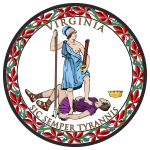Virginia Women's Monument

The Virginia Women's Monument is a state memorial in Richmond, Virginia commemorating the contributions of Virginia women to the history of the Commonwealth of Virginia and the United States of America. Located on the grounds of the Virginia State Capitol, the monument is officially titled Voices from the Garden: The Virginia Women's Monument and features life-sized bronze statues of eleven Virginia women placed in a small granite plaza.The monument was first proposed in 2009 and established by joint resolution of the Virginia General Assembly in 2010. An 18-member commission, along with input from the Library of Virginia and professors of women's history, selected the women to be honored with statues sculpted by StudioEIS in Brooklyn, New York. The granite plaza and Wall of Honor were opened in October 2018 and the monument was officially unveiled with the first seven completed statues on October 14, 2019.The seven women were Cockacoeske, chieftain of the Pamunkey tribe; Anne Burras Laydon, Jamestown colonist; Mary Draper Ingles, frontierswoman and American pioneer; Elizabeth Keckley, seamstress and confidant of Mary Todd Lincoln; Laura Copenhaver, entrepreneur; Virginia Randolph, prominent educator; Adele Goodman Clark, suffragist and activist.In May 2022 additional statues of Sarah Garland Boyd Jones, physician; Maggie L. Walker, businesswoman and teacher; Clementina Rind, the first female newspaper printer and publisher in Virginia; and Martha Washington, inaugural first lady of the United States, were installed.
Excerpt from the Wikipedia article Virginia Women's Monument (License: CC BY-SA 3.0, Authors, Images).Virginia Women's Monument
Capitol Square, Richmond Shockoe Slip
Geographical coordinates (GPS) Address Nearby Places Show on map
Geographical coordinates (GPS)
| Latitude | Longitude |
|---|---|
| N 37.539444444444 ° | E -77.434444444444 ° |
Address
Virginia Washington Monument
Capitol Square
23298 Richmond, Shockoe Slip
Virginia, United States
Open on Google Maps










